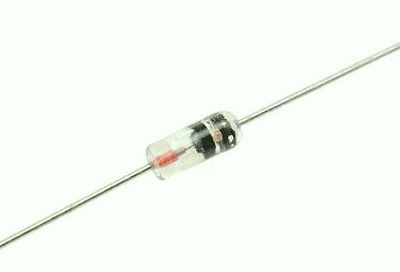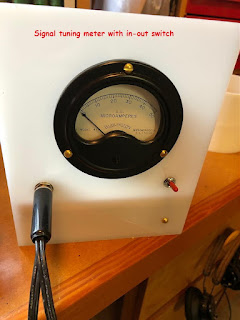 |
| ZQT-263 Thunder Bay, ON (tnx ve3gop.com) |
It's CLE fun time once again. How quickly time zooms by.
When tuning for NDBs, put your receiver in the CW mode and
listen for the NDB's CW identifier, repeated every few seconds. Listen
for U.S. NDB identifiers approximately 1 kHz higher or lower than the
published transmitted frequency since these beacons are modulated with
a 1020 Hz tone approximately.
For example, 'AA' near Fargo, ND, transmitted on 365 kHz and its upper sideband CW identifier was tuned at 366.025 kHz while its lower sideband CW ident could be tuned at 363.946 kHz. Its USB tone was actually 1025 Hz while its LSB tone was 1054 Hz.
Often,
one sideband will be much stronger than the other so if you don't hear
the first one, try listening on the other sideband.
Canadian NDBs normally have an USB tone only, usually very close to 400 Hz. They also have a long dash (keydown) following the CW identifier.
All NDBs heard in North America will be listed in the RNA database (updated daily) while those heard in Europe may be found in the REU database. Beacons heard outside of these regions will be found in the RWW database.
From CLE organizers comes the following CLE info:
Hello all,
Here's your chance to join in this coming weekend's Coordinated Listening
Event which uses some unusual and challenging frequencies.
Any first-time CLE logs will also be very welcome, however modest.
Days: Friday 28 Jan. - Monday 31 Jan.
Times: Start and end at midday, local time at the receiver.
Target: Normal NDBs (not NAVTEX or amateur beacons)
QRG: 260.0 - 269.9 kHz
plus: 440.0 - 1740.0 kHz
Please log the NDBs you can identify that are listed in those ranges, plus
any UNIDs that you come across there.
North America has a modest number of active NDBs in both ranges.
For Europe listeners there are LOTS of targets in the HF range, but they are
mostly well to the east, many of them also competing with strong
Broadcasting Stations. Australia has a few NDBs in both ranges.
You can find all the details of the beacons in these ranges, lists and maps,
if you go to http://www.ndblist.info/cle.htm and click on the 'CLE
SEEKLIST' link.
If you are disappointed by having very few likely targets, maybe you could
listen instead via a remote receiver located nearer to the action? By doing
that many of us could have some very nice surprises, especially listening in
these extreme frequencies. See kiwisdr.com - and please also see the
important footnotes below.
Send your final CLE log to the List, preferably as a plain text email, not
in an attachment, with CLE276 and FINAL at the start of its title.
Please show on EVERY LINE of your log:
# The full Date (or Day no.) e.g. '2022-01-28' (or just '28')
and UTC (the day changes at 00:00 UTC)
# kHz (the beacon's nominal published frequency if you know it)
# The Call Ident.
Other optional details - Location, Distance, etc. - go LATER in the same
line (or in footnotes). If you can give any extra details about new UNIDs,
especially strong ones that may be near to you (maybe their approximate
direction, etc.) it will help us to discover more about them. Please make
your log useful to old and new members alike by ALWAYS including your own location and brief details of the equipment and aerial(s) that you were
using.
We will send an 'Any More Logs?' email at about 20:00 UTC on Tuesday evening so you can check that your log has been found OK.
To be included in the combined results your log must arrive at the very
latest by 09:00 UTC on Wednesday 2 Feb.
We hope to complete making the Combined Results within a day or two.
Good listening
If you are interested in some remote listening - maybe due to local
difficulties - you could use any one remote receiver for your loggings
stating its location and with the owner's permission if required.
A remote listener may NOT also use another receiver, either local
or remote, to make further loggings for the same CLE.
Joachim has put together some very helpful guidance on remote
listening using the Kiwi SDRs, WebSDRs, etc. - he'll be posting it
to NDB List before the start of the CLE.
------------------------------------------------------------------
From: Brian Keyte G3SIA ndbcle'at'gmail.com
Location: Surrey, SE England (CLE coordinator)
------------------------------------------------------------------
These listening events serve several purposes. They
• determine, worldwide, which beacons are out-of-service or have gone silent since the last CLE covering this range
• will indicate the state of propagation conditions at the various participant locations
• will give you an indication of how well your LF/MF receiving system is working
• give participants a fun yet challenging activity to keep their listening skills honed
Final details can be found at the NDB List website, and worldwide results, for every participant, will be posted there a few days after the event.
The NDB List Group is a great place to learn more about the 'Art of NDB DXing' or to meet other DXers in your region. There is a lot of good information available there and new members are always very welcome. As well, you can follow the results of other CLE participants from night to night as propagation is always an active topic of discussion.
You need not be an NDB List member to participate in the CLEs and all reports, no matter how small, are of much value to the organizers.
Remember - 'First-time' logs are always VERY welcome!
Reports may be sent to the NDB List Group or e-mailed to CLE co-ordinator, Brian Keyte (G3SIA), whose address appears above. If you are a member of the group, all final results will also be e-mailed and posted there.
Please ... give the CLE a try ... then let us know what NDB's can be heard from your location! Your report can then be added to the worldwide database to help keep it up-to-date.
Have fun and good hunting!






